Question
Let \(f(x) = {x^3}\). The following diagram shows part of the graph of f .
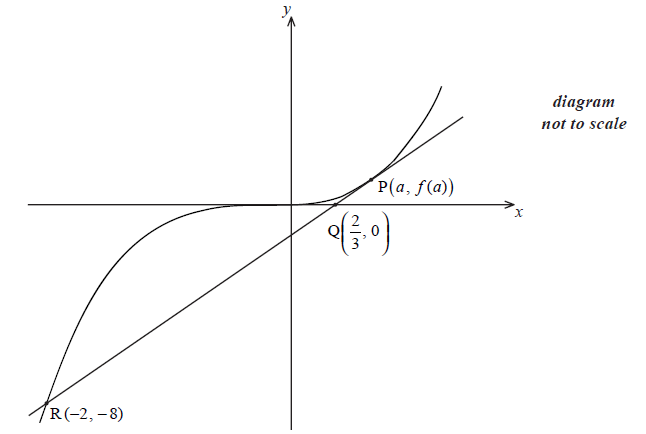
The point \({\rm{P}}(a,f(a))\) , where \(a > 0\) , lies on the graph of f . The tangent at P crosses the x-axis at the point \({\rm{Q}}\left( {\frac{2}{3},0} \right)\) . This tangent intersects the graph of f at the point R(−2, −8) .
The equation of the tangent at P is \(y = 3x – 2\) . Let T be the region enclosed by the graph of f , the tangent [PR] and the line \(x = k\) , between \(x = – 2\) and \(x = k\) where \( – 2 < k < 1\) . This is shown in the diagram below.
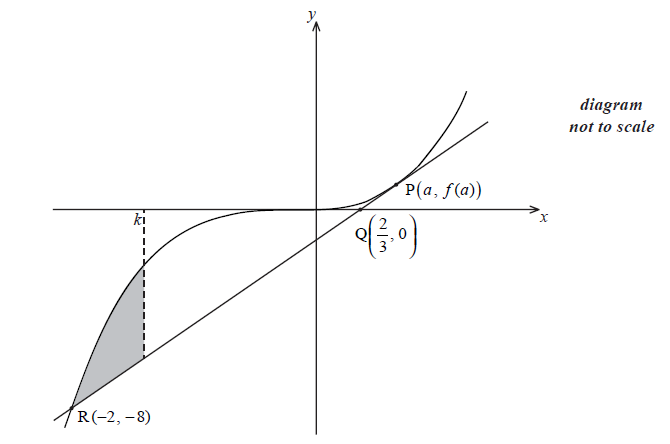
(i) Show that the gradient of [PQ] is \(\frac{{{a^3}}}{{a – \frac{2}{3}}}\) .
(ii) Find \(f'(a)\) .
(iii) Hence show that \(a = 1\) .
Given that the area of T is \(2k + 4\) , show that k satisfies the equation \({k^4} – 6{k^2} + 8 = 0\) .
Answer/Explanation
Markscheme
(i) substitute into gradient \( = \frac{{{y_1} – {y_2}}}{{{x_1} – {x_2}}}\) (M1)
e.g. \(\frac{{f(a) – 0}}{{a – \frac{2}{3}}}\)
substituting \(f(a) = {a^3}\)
e.g. \(\frac{{{a^3} – 0}}{{a – \frac{2}{3}}}\) A1
gradient \(\frac{{{a^3}}}{{a – \frac{2}{3}}}\) AG N0
(ii) correct answer A1 N1
e.g. \(3{a^2}\) , \(f'(a) = 3\) , \(f'(a) = \frac{{{a^3}}}{{a – \frac{2}{3}}}\)
(iii) METHOD 1
evidence of approach (M1)
e.g. \(f'(a) = {\rm{gradient}}\) , \(3{a^2} = \frac{{{a^3}}}{{a – \frac{2}{3}}}\)
simplify A1
e.g. \(3{a^2}\left( {a – \frac{2}{3}} \right) = {a^3}\)
rearrange A1
e.g. \(3{a^3} – 2{a^2} = {a^3}\)
evidence of solving A1
e.g. \(2{a^3} – 2{a^2} = 2{a^2}(a – 1) = 0\)
\(a = 1\) AG N0
METHOD 2
gradient RQ \( = \frac{{ – 8}}{{ – 2 – \frac{2}{3}}}\) A1
simplify A1
e.g. \(\frac{{ – 8}}{{ – \frac{8}{3}}},3\)
evidence of approach (M1)
e.g. \(f'(a) = {\rm{gradient}}\) , \(3{a^2} = \frac{{ – 8}}{{ – 2 – \frac{2}{3}}}\) , \(\frac{{{a^3}}}{{a – \frac{2}{3}}} = 3\)
simplify A1
e.g. \(3{a^2} = 3\) , \({a^2} = 1\)
\(a = 1\) AG N0
[7 marks]
approach to find area of T involving subtraction and integrals (M1)
e.g. \(\int {f – (3x – 2){\rm{d}}x} \) , \(\int_{ – 2}^k {(3x – 2) – \int_{ – 2}^k {{x^3}} } \) , \(\int {({x^3} – 3x + 2)} \)
correct integration with correct signs A1A1A1
e.g. \(\frac{1}{4}{x^4} – \frac{3}{2}{x^2} + 2x\) , \(\frac{3}{2}{x^2} – 2x – \frac{1}{4}{x^4}\)
correct limits \( – 2\) and k (seen anywhere) A1
e.g. \(\int_{ – 2}^k {({x^3} – 3x + 2){\rm{d}}x} \) , \(\left[ {\frac{1}{4}{x^4} – \frac{3}{2}{x^2} + 2x} \right]_{ – 2}^k\)
attempt to substitute k and \( – 2\) (M1)
correct substitution into their integral if 2 or more terms A1
e.g. \(\left( {\frac{1}{4}{k^4} – \frac{3}{2}{k^2} + 2k} \right) – (4 – 6 – 4)\)
setting their integral expression equal to \(2k + 4\) (seen anywhere) (M1)
simplifying A1
e.g. \(\frac{1}{4}{k^4} – \frac{3}{2}{k^2} + 2 = 0\)
\({k^4} – 6{k^2} + 8 = 0\) AG N0
[9 marks]
Question
Let \(f(x) = \frac{{{{(\ln x)}^2}}}{2}\), for \(x > 0\).
Let \(g(x) = \frac{1}{x}\). The following diagram shows parts of the graphs of \(f’\) and g.
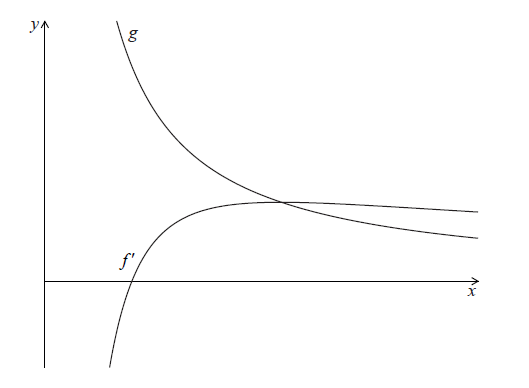
The graph of \(f’\) has an x-intercept at \(x = p\).
Show that \(f'(x) = \frac{{\ln x}}{x}\).
There is a minimum on the graph of \(f\). Find the \(x\)-coordinate of this minimum.
Write down the value of \(p\).
The graph of \(g\) intersects the graph of \(f’\) when \(x = q\).
Find the value of \(q\).
The graph of \(g\) intersects the graph of \(f’\) when \(x = q\).
Let \(R\) be the region enclosed by the graph of \(f’\), the graph of \(g\) and the line \(x = p\).
Show that the area of \(R\) is \(\frac{1}{2}\).
Answer/Explanation
Markscheme
METHOD 1
correct use of chain rule A1A1
eg \(\frac{{2\ln x}}{2} \times \frac{1}{x},{\text{ }}\frac{{2\ln x}}{{2x}}\)
Note: Award A1 for \(\frac{{2\ln x}}{{2x}}\), A1 for \( \times \frac{1}{x}\).
\(f'(x) = \frac{{\ln x}}{x}\) AG N0
[2 marks]
METHOD 2
correct substitution into quotient rule, with derivatives seen A1
eg \(\frac{{2 \times 2\ln x \times \frac{1}{x} – 0 \times {{(\ln x)}^2}}}{4}\)
correct working A1
eg \(\frac{{4\ln x \times \frac{1}{x}}}{4}\)
\(f'(x) = \frac{{\ln x}}{x}\) AG N0
[2 marks]
setting derivative \( = 0\) (M1)
eg \(f'(x) = 0,{\text{ }}\frac{{\ln x}}{x} = 0\)
correct working (A1)
eg \(\ln x = 0,{\text{ }}x = {{\text{e}}^0}\)
\(x = 1\) A1 N2
[3 marks]
intercept when \(f'(x) = 0\) (M1)
\(p = 1\) A1 N2
[2 marks]
equating functions (M1)
eg \(f’ = g,{\text{ }}\frac{{\ln x}}{x} = \frac{1}{x}\)
correct working (A1)
eg \(\ln x = 1\)
\(q = {\text{e (accept }}x = {\text{e)}}\) A1 N2
[3 marks]
evidence of integrating and subtracting functions (in any order, seen anywhere) (M1)
eg \(\int_q^e {\left( {\frac{1}{x} – \frac{{\ln x}}{x}} \right){\text{d}}x{\text{, }}\int {f’ – g} } \)
correct integration \(\ln x – \frac{{{{(\ln x)}^2}}}{2}\) A2
substituting limits into their integrated function and subtracting (in any order) (M1)
eg \((\ln {\text{e}} – \ln 1) – \left( {\frac{{{{(\ln {\text{e}})}^2}}}{2} – \frac{{{{(\ln 1)}^2}}}{2}} \right)\)
Note: Do not award M1 if the integrated function has only one term.
correct working A1
eg \((1 – 0) – \left( {\frac{1}{2} – 0} \right),{\text{ }}1 – \frac{1}{2}\)
\({\text{area}} = \frac{1}{2}\) AG N0
Notes: Candidates may work with two separate integrals, and only combine them at the end. Award marks in line with the markscheme.
[5 marks]
Question
Let \(f(x) = {x^2} – x\), for \(x \in \mathbb{R}\). The following diagram shows part of the graph of \(f\).
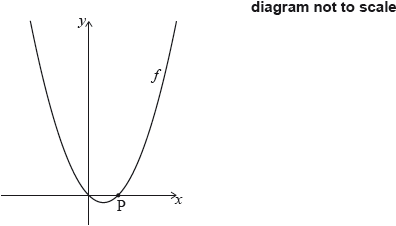
The graph of \(f\) crosses the \(x\)-axis at the origin and at the point \({\text{P}}(1,{\text{ }}0)\).
The line L is the normal to the graph of f at P.
The line \(L\) intersects the graph of \(f\) at another point Q, as shown in the following diagram.
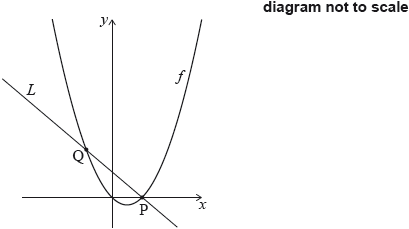
Show that \(f’(1) = 1\).
Find the equation of \(L\) in the form \(y = ax + b\).
Find the \(x\)-coordinate of Q.
Find the area of the region enclosed by the graph of \(f\) and the line \(L\).
Answer/Explanation
Markscheme
\(f’(x) = 2x – 1\) A1A1
correct substitution A1
eg\(\,\,\,\,\,\)\(2(1) – 1,{\text{ }}2 – 1\)
\(f’(1) = 1\) AG N0
[3 marks]
correct approach to find the gradient of the normal (A1)
eg\(\,\,\,\,\,\)\(\frac{{ – 1}}{{f'(1)}},{\text{ }}{m_1}{m_2} = – 1,{\text{ slope}} = – 1\)
attempt to substitute correct normal gradient and coordinates into equation of a line (M1)
eg\(\,\,\,\,\,\)\(y – 0 = – 1(x – 1),{\text{ }}0 = – 1 + b,{\text{ }}b = 1,{\text{ }}L = – x + 1\)
\(y = – x + 1\) A1 N2
[3 marks]
equating expressions (M1)
eg\(\,\,\,\,\,\)\(f(x) = L,{\text{ }} – x + 1 = {x^2} – x\)
correct working (must involve combining terms) (A1)
eg\(\,\,\,\,\,\)\({x^2} – 1 = 0,{\text{ }}{x^2} = 1,{\text{ }}x = 1\)
\(x = – 1\,\,\,\,\,\left( {{\text{accept }}Q( – 1,{\text{ }}2)} \right)\) A2 N3
[4 marks]
valid approach (M1)
eg\(\,\,\,\,\,\)\(\int {L – f,{\text{ }}\int_{ – 1}^1 {(1 – {x^2}){\text{d}}x} } \), splitting area into triangles and integrals
correct integration (A1)(A1)
eg\(\,\,\,\,\,\)\(\left[ {x – \frac{{{x^3}}}{3}} \right]_{ – 1}^1,{\text{ }} – \frac{{{x^3}}}{3} – \frac{{{x^2}}}{2} + \frac{{{x^2}}}{2} + x\)
substituting their limits into their integrated function and subtracting (in any order) (M1)
eg\(\,\,\,\,\,\)\(1 – \frac{1}{3} – \left( { – 1 – \frac{{ – 1}}{3}} \right)\)
Note: Award M0 for substituting into original or differentiated function.
area \( = \frac{4}{3}\) A2 N3
[6 marks]
